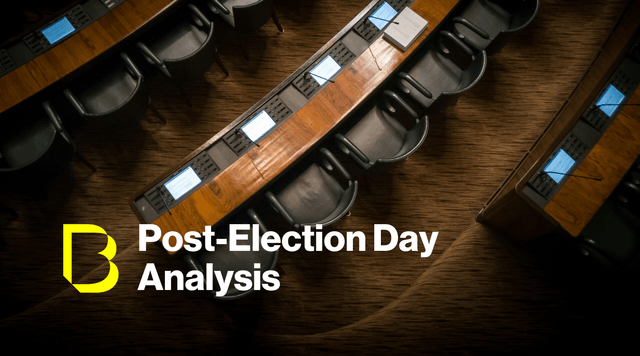Overview
With two weeks until the 2024 U.S. presidential election, Vice President Kamala Harris and Former President Donald Trump are in an extremely close race and intensifying their campaigns in the seven key battleground states – Nevada, Arizona, Wisconsin, Michigan, Pennsylvania, Georgia and North Carolina – where the race for 270 electoral votes will be decided.
Both candidates also recently visited hurricane-hit areas in North Carolina and Georgia, both where early voting has begun. Trump criticized the federal response to the hurricanes, while Harris faced backlash for interviews conducted during the storms. Last Friday, both candidates campaigned in Michigan, with Harris visiting Grand Rapids, Lansing and Oakland County, and Trump holding a roundtable in the same county and Detroit.
Harris focused on courting Black voters, with former President Barack Obama taking to the stage in Pittsburgh to urge Black men to vote. Harris also launched her “Opportunity Agenda for Black Men” to strengthen support from a key Democratic demographic, offering benefits aimed to supporting Black men and women. She also participated in her first-ever FOX News interview after Trump declined a request for another debate. In a heated interview with Bret Baier, Harris aimed to distance herself from President Joe Biden on immigration and border security. Her media blitz also included appearances on “The View,” “The Howard Stern Show,” “The Breakfast Club,” the “Call Her Daddy” podcast, a Univision Town Hall and CBS’ “60 Minutes.”
Meanwhile, Trump focused on attempting to secure support from female voters in Georgia but drew criticism for calling himself the “father of IVF.” He also led campaigns across California, Nevada, Arizona and Colorado, focused on immigration – a defining issue of his platform.
Campaign Fundamentals
- Polling: Latest national polling indicates an extremely tight race, with Harris up by 1.8 points. Since last month, Harris’s lead has shrunk, signaling a shift in enthusiasm toward Trump, likely driven by declining support from Latino and Black men. Trump has focused on winning Hispanic and Black voters, especially men, with an emphasis on the economy and crime.
- Early Voting: Over 17 million people have already participated in early voting, underscoring how the pandemic permanently shifted voting habits and cemented early voting as a fixture in the American democratic process. Several states, including North Carolina and Louisiana, have set first-day early voting records. In Georgia, daily records for in-person early voting have been broken nearly every day since the polls opened, with over 1.5 million ballots cast in this key battleground state, indicating a high level of enthusiasm across the state. Democrats tend to use early voting and vote-by-mail more than Republicans, but with the Republican party having encouraged early voting in this election, it remains to be seen what impact this will have on the race.
- Down-Ballot Races: The race for a majority in the U.S. House of Representatives is close to a coin flip, with the House’s control likely being determined by just 42 competitive races. As of now, there’s a 50/50 chance of either party winning the lower chamber, with some polling showing a slight edge for Democrats. In the upper chamber, the latest polling shows Republicans are likely to win the Senate, flipping control and potentially dividing Congress. Republicans are leading in key races in Montana, Texas and Florida, and new polls indicate that the Senate race in Wisconsin is tightening, potentially offering an additional pick-up opportunity for Republicans.
- Democrats: Harris intensified her attacks on Trump over the weekend and is holding events with former Republican Representative Liz Cheney in Pennsylvania, Michigan and Wisconsin suburbs, where voters have been shifting away from the Republican party. Later this week, she’ll join the Obamas for rallies in Michigan and Georgia, aiming to boost turnout in key urban and suburban areas. Her strategy focuses on attracting undecided voters, particularly Republican-leaning moderates and independents, including those who backed Nikki Haley in the primaries. Her advisers believe contrasting with Trump will help draw in these voters, while also energizing liberals. Given current polling trends, Harris will need to sustain her momentum over the next two weeks to keep voters focused on her issues and candidacy.
- Republicans: Trump has maintained his attacks on Harris’s record, including an unusual campaign stop at a McDonald’s in Pennsylvania over the weekend. The visit drew significant media attention, both praising and criticizing the stunt, as Trump used the opportunity to challenge Harris’s claim of working at McDonald’s during college. While his messages across events and issues remain inconsistent, immigration has emerged as the most effective issue driving his campaign. Trump and his surrogates are using the crisis at the border in an attempt to ensure every voter concerned about the issue is motivated to go the polls.
- Issues: The economy remains a top issue for voters, followed by concerns about democracy, national security and immigration. Trump remains as the perceived stronger candidate on the economy; however, Harris has closed some of that gap thanks to new economic data indicating a strong labor market and falling interest rates from the Fed. Additionally, abortion and reproductive rights continue to climb in terms of issues important to voters – a win for Harris overall.
What’s Next
- A Focus on Battleground States: In the seven key battleground states, polls are slightly shifting momentum toward Trump as the race is tied in Wisconsin, Pennsylvania, Michigan and Nevada and Trump is narrowly ahead in Georgia, North Carolina and Arizona. Due to Pennsylvania’s crucial 19 electoral votes, Harris and Trump have poured over $538 million into advertising there – $148 million more than in Michigan, the next closest battleground. As Election Day nears, expect both campaigns to intensify their messaging to diverse voter groups in these states.
- Biden’s Response to Conflict in the Middle East: Trump has been trying to tap into the frustration with Harris over the U.S.’s support for Israel’s actions in Gaza and Lebanon, following the October 7, 2023, attack by Hamas. However, Biden’s recent tough stances to end the conflict and prevent its spread could strengthen Harris’s campaign in Michigan, home to many Arab and Muslim American voters who may have been hesitant to support her given her alignment with Biden’s previous pro-Israel policies. However, a harder line on Israel risks alienating pro-Israel voters, a group that Trump is actively going after.
- November Jobs Report: The final pre-election jobs report is set for November 1, and will be pivotal in shaping swing-state undecided voter perceptions of the economy. Strong numbers could support Harris while a negative report may weaken her standing.
- Election Day: Since the 2020 election, changes to election laws and voting access have become highly divisive. With the new laws, some states won’t even begin processing mail-in ballots until Election Day, and other states, such as Michigan, have already stated that results won’t be posted until the day after Election. Given these complications, Americans may face a wait of several days for the final election result.
Bottom Line
In the last two weeks of the race, success will boil down to getting out the vote and appealing to key voting blocs in the battleground states. Harris needs to target low-propensity Democratic voters, while Trump must replicate his 2016 and 2020 turnout.
Companies and organizations should continue to strategize against either outcome of the election with a focus on safeguarding their license to operate, maintaining trust with stakeholders and ensuring productive levels of employee performance. We are currently operating with “known unknowns,” a phrase coined by Former Secretary of Defense Donald Rumsfeld. Staying informed by actively monitoring news and social media channels, updating risk plans and allowing for regular, timely and accurate communication to employees and external stakeholders will be imperative for organizations to succeed in the coming weeks.
You might also like
Explore all
Key learnings from a busy first week of the new U.S. presidential administration

Post-Election Day Analysis

November 1, 2024: State of the Race

